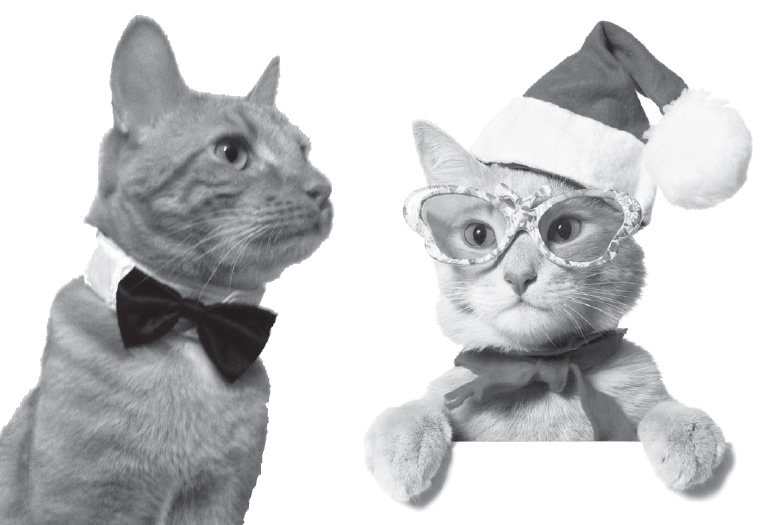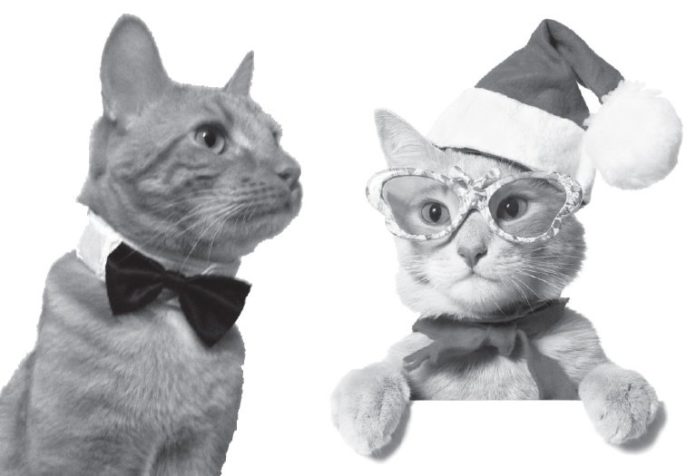

Click on Facebook, Instagram, YouTube and other social media sites, and it won’t take you long to find an orange tabby sporting a bowtie, a Scottish fold decked out in a flowery dress or an irritated Siamese attempting to paw off a tiny hat that flattens his ears and irritates his whiskers.
The pet fashion industry has escalated into a multi-million dollar business, with a whopping $350 million spent annually for pet Halloween costumes alone, according to the National Retail Federation.
As more pet owners delight in dressing up their pets, including cats, for special occasions, family holiday photos and pet charity events, it begs the question: Why? And secondly, is it healthy or harmful to turn the family cat into a clothes hound?
“There are pros and cons in dressing up pets,” says Allen Schoen, DVM, Ph.D., a pioneer in integrative animal health care and author of Kindred Spirits: How the Remarkable Bond Between Humans and Animals Can Change the Way We Live. “Dressing up pets is an opportunity for some people to just be joyful, fun loving and it brings the child out in us. It can increase our laughter, which is all positive in supporting our overall health and immune system, but care must be taken to make sure that the pet also enjoys being dressed up.”
Loud Meows. How can you tell if your cat welcomes accessories or prefers to stick with wearing a breakaway collar and identification tags? “Cats who do not like being dressed up will immediately try to take off the items in any way that they can,” says Dr. Schoen, a graduate of Cornell University College of Veterinary Medicine. “They may meow loudly, hiss, flatten their ears and try to wiggle out of the outfits.”
One important consideration is avoiding costumes that could flatten cats’ whiskers. They use these tactile hairs to sense and navigate their environment. In addition to the whiskers on the sides of their nose and the back of their front legs, cats also have short whiskers above their eyes. That means foregoing decorative face masks, sunglasses and leggings.
In addition, forcing a cat to wear items against his will can sour your bond and possibly make it more challenging for him to receive veterinary care. “Some cats can become aggressive or fearful of you handling them,” says Dr. Schoen. “Some may go under a bed to hide from you. This insistence of putting clothes on them can make them more leery and fearful of being handled when they really need to be, such as when going to the veterinarian or receiving medication.”
Accessories, Too. One thing is for certain: More owners are buying clothing and accessories for their cats and dogs. These days, pets are not just part of the family. They’re major influencers in how some pet owners target their discretionary dollars, says Laurren Darr, founder of the International Association of Pet Fashion Professionals, based in New York City.
There is even a National Dress up Your Pet Day, the next one set for Jan. 14. Colleen Paige, a celebrity pet lifestyle expert and animal advocate, founded the event in 2009. It promotes pet adoption and continues to expand each year.
In Manhattan, the renowned Fashion Institute of Technology has added a pet fashion curriculum. Students can earn a certificate in pet fashion after completing three weeks of study that includes pattern-making and pet fashion design. “From bulldogs to American bobtails, pets are strutting designer stuff and owners are vying for best-dressed awards for their four-legged family members,” the course description says, adding that ease of dressing and safety tips are considered in relation to T-shirts, winter coats and couture ensembles.
“Pet apparel is moving from being simply cute to being highly functional. It’s all about unique fabrics — light and breathable, cooling or warming,” says Dana Humphrey, owner of a public relations agency specializing in the pet industry whose clients include the institute.
Whether you and your cat mutually agree to turn him into a fashionista, respect that your cat is not a human child, cautions Dr. Schoen. “There is a potential issue of becoming anthropomorphic to an extreme by treating them too much like children and possibly forgetting that they are unique animal beings with unique personalities and health issues,” he says.
Dr. Schoen doesn’t put clothing on his personal pets. “I do not feel a need to do so,” he says. “I enjoy and love them just as they are.”




